Feature Interview with Peter Matkovich
April, 2009
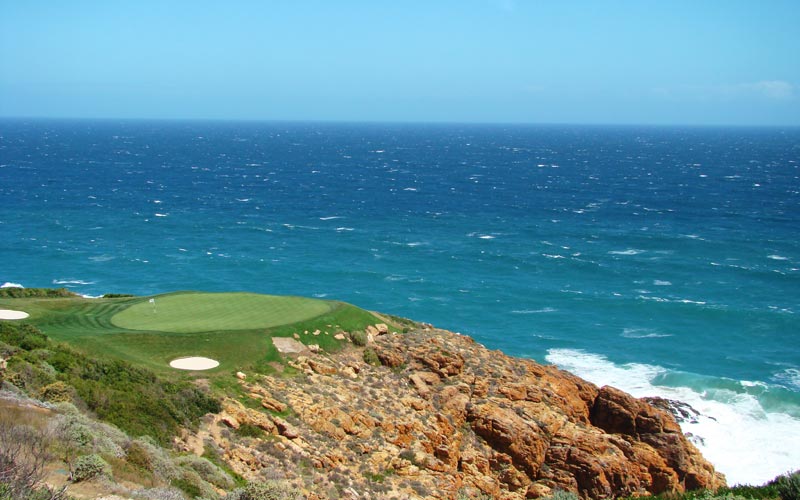
The downhill par three seventh is but one of the spectacular cliffline holes at Pinnacle Point.
1. Tell us about your playing career as a golf professional. What were some of your favorite courses and why (i.e. did you like courses where you could shot low numbers or did you appreciate courses that had well placed hazards that complicated achieving a good score)?
I have been a golf pro for 41 years, but I was never a successful tour professional. Spent 3 years playing in Europe, 1 year Australia, played the Sunshine Tour from 1968-80. Played in two Opens at Carnoustie (1968) and St Andrews (1970). I’m a big fan of links golf. Loved playing the Scottish links in prequalifying for the Open.
Admire strategic courses, with balance; long and short par 4s, love short par 4s. My thinking is influenced by short par 4s on Scottish links. In South Africa I loved the fifth at the old Kensington course, the 16th at Wedgwood Park. High risk and reward needed.
2. How has the game changed at the top level since when you left the tour?
So many more golfers in the game today. Lob wedge has changed the game. Tradition, etiquette has changed. We never had coaches/video, gurus, fitness experts.
3. At what point and why did you become interested in golf course architecture?
I grew up as a youngster in Shabani, near Fort Victoria in Southern Rhodesia. All the mines had magnificent golf courses. I played at Shabani Golf Club, an 18-holer. Early on I realized I was not going to be a good player (about the age of 25) but loved golf courses “ the look and feel of them.
4. In what way(s) does being a top flight player influence you as a designer?
I was never a top flight pro but fortunate to play with all the top players of my era. Played with all four Grand Slam winners “ Gene Sarazen, Ben Hogan, Gary Player and Jack Nicklaus. Personally think it is essential to know how to play certain shots off certain lies to certain types of greens, under tournament conditions. Too much landscaping and not enough golf in today’s course architecture. What seems to be important today is postcard and signature holes. Fortunate as a club pro to play with members up to 80 years old to understand how they play the course.
5. Other than through ridiculous length, is it possible to challenge a power golfer like Ernie Els while still building a golf estate course that will be fun for its members?
Worst phrase is “course must be fun for everyone.” Get variation of holes and multiple tees. Have a good balance of holes, wide in certain landing areas, others narrow, risk and reward at different distances for different skill levels. All about variety and balance. One area you can challenge everyone is in your greens design. Everyone can putt. Hit it in the wrong section and you are seriously tested.
You cannot design a golf course for everyone. You’re ruined if you try to please everyone.
Love catchment areas on links courses where balls feed.
6. What is an example of a hole that you have built that does both?
The fifth hole at Pinnacle Point. Has 5 or 6 separate tees. Variable winds add to the hole. Offers top player the chance of an eagle, and high handicap can make his par.
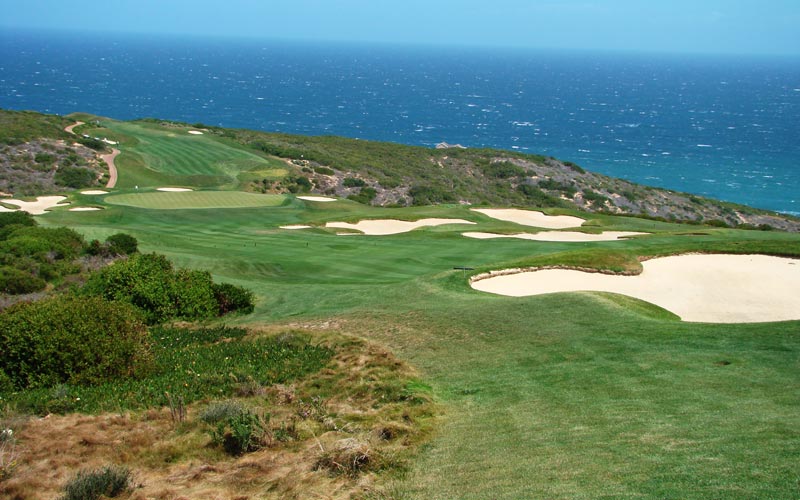
The par five fifth at Pinnacle Point provides multiple routes which allows all golfers to enjoy the hole.
7. Located in the Ballito area of South Africa, your first project was Umhlali Country Club in 1975. That’s thirty-four (!) years ago. How have you evolved as a golf course architect over that period of time? How have you tastes changed and/or been affirmed?
My passion for golf course design has grown over the years as I’ve gained more experience. For 20 years I did course superintendent work, which hugely increased my knowledge of course design. The ingredients for a good designer is to be able play to a high standard, and knowledge of course maintenance.
A danger in golf course design is big budgets. Your direction comes from listening to the land, doing what the land dictates. You must not create chocolate box holes one on top of the other.
I’ve always loved the links courses, and go over annually to Scotland/Ireland to play them, because the more I get into design the more I think the old courses with their strategy and natural features is what is special.
8. Tell us about the process of creating the dunes at the Ebotse Golf & Country Estate. They appear natural yet it was a tremendous earthmoving exercise.
Ebotse was an old derelict quarry site with huge kaolin dumps that had to be moved, so we used this material (2.5 million cubic metres) to create shapes and elevation and it does give it a dunes kind of look. We reclaimed ground to fit in holes.
9. What were the three best elements of the site at Pinnacle Point and how did you incorporate them into your design?
The spectacular views, and opportunity to create clifftop holes. And the fauna and flora. We designed every hole to bring out the views. Every hole has a sea view. The cliffs gave us a wonderful opportunity for risk and reward holes. We planted the vegetation right up to the tees and greens etc.
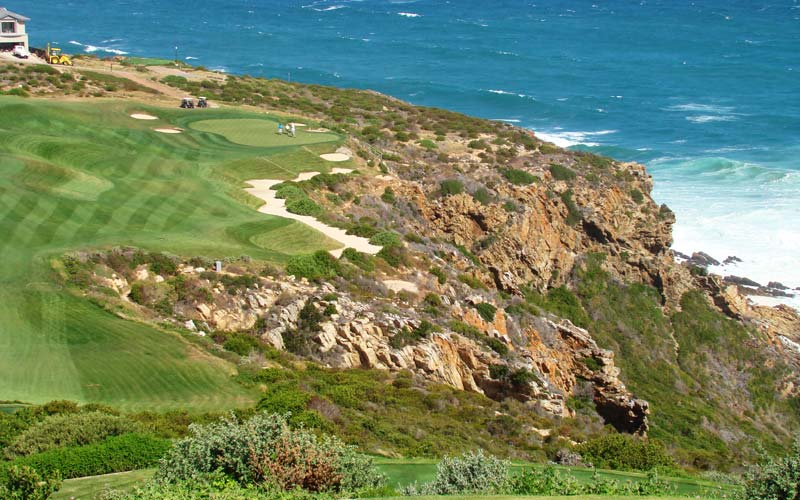
The 410 yard twelfth hole plays to one of the most interesting greens at Pinnacle Point.
10. What were the three biggest drawbacks to the site at Pinnacle Point and how did you work around them?
Severe slope of the ground. Extreme elevation changes. Always more difficult designing uphill. Environmental restrictions. Incorporating houses, and getting harmony between real estate and golf course.
11. The eighth hole at Pinnacle Point is South Africa’s version of sixteen at Cypress Point. Set along the coastline, the golfer can play out left and treat it as a short par four or in favorable conditions, have a crack at the green from the tee. In short, it is a fabulous use of the coastline. Tell us about how it came to be.
I don’t use a computer to design holes, and instead rather extensively walk a site. The eighth was thickly choked with bush, difficult to walk it. Green site was fine. The hole presents itself as a short par 4 and it was the only opportunity on the clifftops to fit in such a hole because of environmental restrictions.
12. The eighteenth at Pinnacle Point is a fabulous finishing hole with all kinds of playing options. Walk us through the design process, from first envisaging this sweeping dogleg left all the way through its construction. Was the central bunker 115 yards from the green always a key feature?
Construction hugely difficult balancing on top of clifftop, and leveling out the fairway. It was a sheer slope. Had to cut back the ground to make the landing area visible from the back tee. The thinking here is to place the tee shot in the right position so that it feeds down on to one of the few level areas. It promotes a risk and reward second shot to the green. I like an 18th hole where you can score anything between 3 and 7. Construction team did an incredible job working in extreme conditions on the edge of cliffs, creating bunkers etc. The central bunker is a key feature in that it creates 3 distinct shots for your second shot. You either lay up short of it if you’ve hit a bad drive, or you play to a safer route over the bunker, or hit it straight on the green.
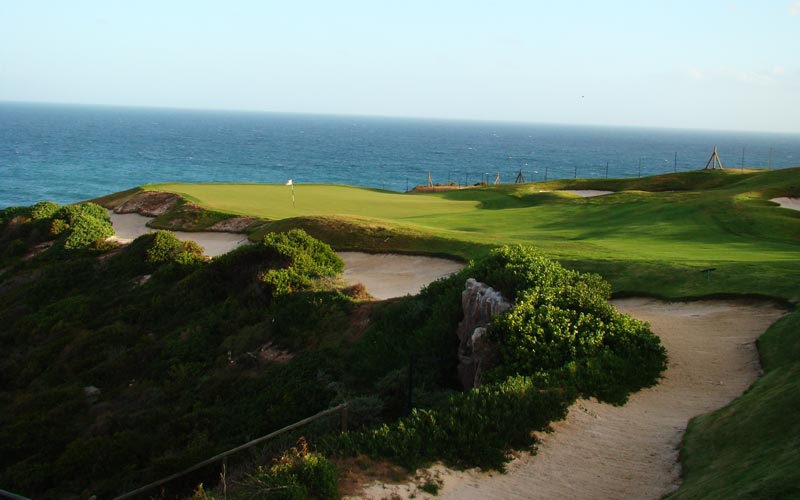
The long right to left sweeping par five eighteenth at Pinnacle Point might reminds many of another of the world’s great finishing holes – the eighteenth at Coore & Crenshaw’s Plantation Course at Kapalua.
13. Many high profile modern courses in South Africa create a faux links environment, sometimes with great success such as the Links Course at Fancourt. Yet, one design of yours went the other way. At the Elements Private Golf Reserve in Bela-Bela, you have won numerous awards including best new course in 2005 as critics embraced how it melds into the natural African landscape. Tell us how you bucked the trend of going with faux links and had Bela-Bela reflect its natural landscape.
I’m a proud African and love our natural indigenous bush, and we need to create courses unique to Africa using our natural features, and still keep strategy high on the design criteria. I want tourists to come to our country to play courses that reflect our country, just as we go to Ireland/Scotland to play links courses.
14. In this global economic slowdown, what is the health of a) the game of golf in South Africa, and b) golf course design on the African continent?
South Africa has a huge advantage in that more people are playing the game, particularly the black population and more women golfers. It was mostly men before. Emerging market helps. But there is a slowdown in the number of courses being built, some have stopped construction. Economy has put a stop to course design here, but there is a lot of interest coming from other African countries, Mozambique, Zambia, Tanzania, Kenya and Nigeria. Mozambique has plenty of water.
15. When should narrowness play a role in golf design? What is an example of a hole that you have built that captures this element?
I love narrow golf holes, intimidating, and plays a huge role in course design to get adrenalin going. I have done several holes where this is an element, at variant lengths. The 11th at Hermanus, the 6th at Pinnacle Point, No 7 at Ebotse, Elements No 6, very narrow holes at Umhlali.
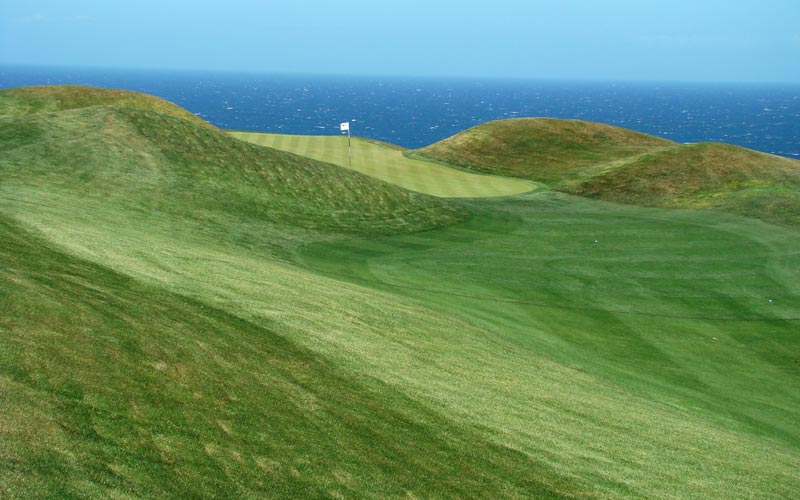
The last one hundred yards of the sixth hole at Pinnnacle Point narrows considerably, putting a premium on accuracy.
16. Which are your three favorite a) Golden Age designs in Africa, b) modern designs in Africa that you didn’t do, and c) three designs of yours that you hope a visitor could see to gain an appreciation of your range of work?
A) Durban Country Club from the 1920s, Humewood (1930) and the East course at Royal Johannesburg & Kensington (1935).
B) I enjoy our modern golf courses, but I would be reluctant to categorise any favourites. However, Gary Player CC, St Francis Links, Pearl Valley, the Links at Fancourt, Leopard Creek are outstanding examples.
C) Pinnacle Point, Ebotse, Elements.
17. What’s a hidden gem that you didn’t design that you would recommend travelers see? What do you like so much about it?
Maccauvlei is very natural, great strategy (I did a restoration work almost 10 years ago); Sishen in the Northern Cape, natural feel, next to the desert, cut through a kameeldoring forest; East London, an old classic design on a remarkable site in the dunes next to the ocean; Goldfields West, an old mining course outside Johannesburg; King David next to Cape Town Airport.
18. A rich developer has 1,000 acres in sand dunes at one of the stable countries north of South Africa; why should he hire you as the architect for this walking only golf course?
My desire in golf course design is to create a course somewhere along the coast of Africa. I understand and know the African culture, the countries (having travelled extensively throughout Africa), the grasses, the climate, I would be on site all the time through the process (as at Elements), and would have a feel for the land, for the topography, personal attention to detail, and have a feel for the ground. There is also my proximity to any African site, living as I do in South Africa. Accessibility is key to this project, being so remote. One of the important aspects of design is time, and I have that. It would be the culmination of my work in golf course design to do something of this stature.
Stuart McLean, editor of Golf Digest South Africa, helped Peter compose his answers to this interview.
The End








